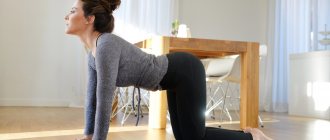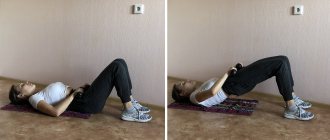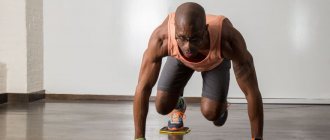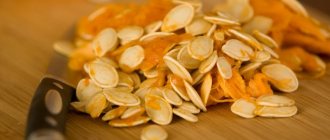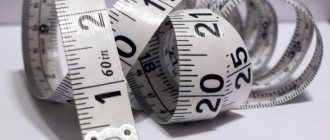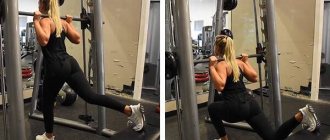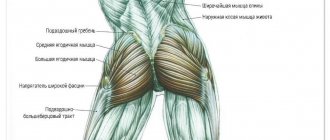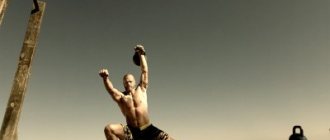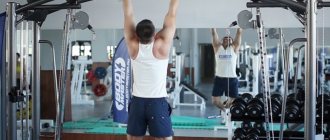There are many reasons to start playing sports. Scientists have proven that people who lead an active lifestyle are more likely to be in a good mood, achieve better learning results, and have higher self-esteem and stress resistance. Sport strengthens the immune system, improves metabolism, makes the skin elastic and beautiful, slows down the aging process and literally prolongs life.
Exercising helps in the fight against excess weight and creates a slim and attractive body. This is not a complete list of manifestations of a healthy lifestyle, an integral part of which is sport, which is becoming increasingly popular every day among both young people and older generations.
Lunges with dumbbells for girls and men
Lunges are an alternative solution for girls who want to find an ideal figure. They will allow you to form the attractive and firm buttocks that everyone dreams of now. However, female and male bodies are different. When performing absolutely any exercise, this must be taken into account.
With the help of scientific research, as well as experimentally, it was found that strength training has a beneficial effect on a woman’s overall health, corrects her figure, and strengthens her muscles. But the ligaments do not tolerate such loads well, so preference should be given to those exercises that do not overload our spine. In other words, they should be performed with lighter weights. Men, however, are less resilient in terms of stamina .
The most versatile exercise that targets the lower body is the lunge. They help improve three components at once:
- increase overall strength;
- increase stability;
- develop a sense of balance.
You can pump up your buttocks, thighs and legs anywhere: both in the gym and at home, if you have dumbbells that can even be replaced with ordinary water bottles. The technique is the same for men and women, but, as mentioned above, the weight selected for the exercise will vary somewhat due to the physiological characteristics of the female body . But there is one more difference. When performed correctly, a man has the opportunity not only to correct the relief of the muscles of the legs and buttocks, but also to pump up his shoulders. But women rarely pursue such a goal.
Until the age of eighteen, it is generally not recommended to perform strength exercises with very heavy weights, but it is better to pick up a lighter weight that will allow you to repeat the exercise 10-15 times. A weight of more than 15 kilograms can cause harmful effects on the female genital organs .
This exercise is also useful for older people. Although muscle flexibility decreases with age, joint mobility can be improved, but with extreme caution. We do the first approach with our own weight, with caution, without sudden movements, we increase the length of the lunge. Before this, we perform a thorough warm-up, warming up the muscles well. Lunges are a kind of imitation of walking, and this is the main exercise for maintaining the physical health of older people. Experts also recommend a separate version of this exercise - “fencing lunges”.
Contraindications
Squats are not recommended in the following cases:
- untreated musculoskeletal injuries;
- scoliosis;
- high blood pressure;
- hernias;
- heart disease;
- dysfunction of the vestibular apparatus;
- recovery period after surgery;
- in the first 2 months after birth.
If you have health problems, be sure to see a doctor before starting training. Otherwise, you risk harming yourself.
Injury hazard
No other exercise will help so effectively in shaping the relief of the legs. Some athletes prefer to perform this exercise without weights, but those who strive to achieve high results use it. To avoid injury, before performing the exercise, it is imperative to warm up thoroughly and then follow safety precautions. The first approach is recommended to be performed with your own weight (without weights). Failure to follow the instructions may result in serious injury or other adverse consequences.
Working muscles
To perform this exercise effectively and correctly, you need to understand which muscles are involved. Different lunge variations shift the body's center of gravity in different ways and place emphasis on different muscle groups. At the same time they do the job:
- quadriceps (one of the two main working groups);
- hamstring biceps;
- adductor muscles.
In addition, the gluteus maximus (the bulk of the buttocks) and gluteus medius muscles, as well as auxiliary muscles: the gastrocnemius, abs and spinal erectors, also take part. The gluteal muscles are most involved during lunges . Some classifications classify lunges as a type of squats, which in principle can be argued, because the leg in front does not return to the leg behind. But the similarity of the effect from these two exercises allows us to draw this conclusion.
Exercise technique
The first rule that must be followed is: the knee of the working leg should under no circumstances extend beyond the toe. It's not scary if it comes out just a little, but neglecting this rule will put stress on the knee joint and can damage it. In the gym, the trainer will point out your mistake, but if you are doing the exercise at home, it is better to stand sideways in front of the mirror and check this moment yourself.
The easiest way to perform lunges is with dumbbells, as opposed to a barbell. For beginners, it is best to choose a light weight and start with a small number of repetitions and sets, gradually increasing them.
Execution algorithm:
- hold dumbbells in our hands;
- We step forward with one foot;
- keeping the thigh parallel to the floor, we lower ourselves down;
- the second leg should be at an angle of 90 degrees;
- We push off with the front leg and get to the starting position.
For those who want to lose weight, it is better to perform forward lunges, as they require a little more energy. But don’t forget that this puts more strain on your knees. So you can perform this exercise without changing your position, constantly alternating your legs. The optimal number of repetitions to start with is 10 on one leg.
Lunge variations with dumbbells
As we have already said, this exercise has several types. All types of lunges have their own variations with certain rules and specific execution techniques.
Types of lunges:
- forward lunges;
- reverse lunges or backward lunges;
- lateral;
- Bulgarian;
- cross.
Lunges forward
Forward lunges with dumbbells are a classic version of this exercise. The execution technique is described above.
Varieties of forward lunges:
- lunges on each leg, when the right and left legs are alternately working;
- lunge forward with one leg, when the same leg is the working leg.
Reverse or back lunges
Backward lunges are similar to forward lunges. The difference is that when performing lunges we take a step with our working leg backwards. The technique for performing backward lunges is the same as in the previous version, the principle of execution is the same.
In training, you can alternate lunges forward and backward.
Lateral
There are variations of lunges with dumbbells, such as side lunges or side lunges. At the same time, the inner surface of the thigh is well worked out, balance and a sense of balance are developed.
Side lunge technique:
- we start by taking the starting position and taking dumbbells in our hands;
- we take a step to the side, as these are side lunges;
- the working leg bends at the knee, which does not extend beyond the toe;
- the supporting leg straightens;
- push off and return to the starting position;
- We do several repetitions.
Bulgarian lunges
These are lunges that are done from an elevated position. A bench is usually used for this. It's simple - we start with preparation, stand with our backs to the bench, feet in one line. We put one leg back on the bench, and with the other we take a wide step forward, from this position we do a squat, not forgetting about the knees and toes.

During the execution, the hamstrings are fully stretched and contracted. Blood flow to the buttocks also increases.
Cross
This is a rare lunge variation. It consists of moving the front leg in the opposite direction. In this case, the leg must be brought to the level of the opposite shoulder. In this case, the knee cannot be brought inward.
We start with the correct position of the legs. The principle is the same, only we bring the working leg back, behind the supporting leg.
Then squat down, bending your supporting leg. To make it more difficult, we do lunges with knee lifts after performing a squat. Such lunges are also performed with dumbbells in hands and with a barbell.
Such exercises are effective for girls who want to work out the inner thigh.
Exercises for the buttocks with dumbbells
Thanks to the gluteal muscles, a person is able to perform basic actions: turn, bend and bend. A sedentary lifestyle often makes it difficult to complete these simple tasks. As a conclusion, the muscles need to be strengthened. For this, several more exercises are suitable to help tighten the buttocks, which can be done both with and without weights:
- squats;
- plie;
- "Scissors";
- hyperextension;
- deadlift;
- stepping onto the platform.
This is far from a complete list of all possible exercises for this muscle group, but they are the most effective and easiest to perform. Now let's take a closer look at some of them.
It is strictly prohibited to begin training without preliminary warm-up. This will not only reduce efficiency and cause discomfort in the body, but can also lead to injury! Only after thoroughly warming up the joints can you pick up weights.
Squats
Squats have long occupied a leading position in the top of the best exercises that not only pump up the buttocks, but also support the general physical condition of a person. Just like any other exercise. it must be done correctly. To do this, you need to follow the already established algorithm:
- We stand in the starting position. We take dumbbells in our hands, the weight corresponding to you, and hold them with your arms down along your body (it is also allowed to put them on your shoulders);
- Legs at shoulder level, back straight, chest looking forward (we should never slouch while doing the exercises). Do not lift your heels off the floor;
- While lowering, we inhale (knees pointing towards the toes). On the way up we exhale. We set the depth of lowering for ourselves, taking into account our capabilities and the preparedness of the body. We are trying to achieve such a result that a 90-degree angle is formed in the knees. Toes and knees form a straight line. As you rise, keep your knees bent to reduce the load on your joints. The body is slightly tilted forward, and the pelvis is laid back.
Plie
During squats called “Plie,” the muscles we need in this topic are involved. The emphasis is on the buttocks, as well as on the inner thigh. We spread our legs as wide as possible, and turn our toes outward as much as the stretch allows. We hold the dumbbell down with both hands and do not move it anywhere. You need to feel the tension in the inner thigh and lower yourself down as much as possible. The buttocks tense as you push your heels off the floor. Ideally, you want to ensure that your thighs are parallel to the floor, but, as a rule, this result can only be achieved after a certain amount of training.
About squats for weight loss: how to squat correctly without weight for men
This is such an irony, the secret of a healthy body and toned buttocks was revealed to us in early childhood. Squats are an exercise that is familiar to absolutely everyone.
It’s not for nothing that the much-hated daily exercise in the morning was accompanied by a dozen squats. This exercise is basic, but extremely effective. Combines strength and aerobic exercise.
When performing it, various muscle groups of the body are involved:
- Anterior serratus
- Abdominal group (external rectus and oblique abdominal muscles)
- Erector spinae muscle
- Quadratus lumborum muscle
- Tensor fascia lata
- Quadriceps (vastus literalis)
- Iliotibial tract
- Tibialis anterior muscle
- fibula
- Soleus
- Gluteus maximus
- Gastrocnemius
- Biceps femoris
- Achilles tendon
Having revealed the secret of toned buttocks, those who like to go to extremes begin to squat frantically. The bigger, the better. Of course, the fact that you are on the move can save you a few calories, but it will not lead to the desired result. You need to approach things wisely.
So how many squats should you do per day?
To achieve your goal, you need to engage in physical activity regularly, but without fanaticism, relying on your feelings. You can easily forget, overdo it and harm your health.
- A workout lasting 20-30 minutes will be effective. Several exercises, 3-4 approaches.
- Adjust the number of squats according to your capabilities. For example, you can start with 20, and increase or decrease on the next round.
- The frequency of training should be such that the body rests. Once every 2-3 days you should take a break or give preference to light training.
- If the sport is new to you, create a special program on your own or with a coach in which the load will increase gradually without causing harm.
It is important to understand that a competent and comprehensive approach to solving a problem is effective. Squatting and chewing Snickers at the same time is not an option. The fewer harmful foods in your diet, the greater the results from physical activity.
Clarification for lovers of extremes: hungry fainting and dreams about chocolates will only bring harm! Measurement is needed in everything.
If we talk about regularity and frequency globally, then in order for the result to be clearly expressed, training must last more than a month. Yes, with high loads and intensity, the first and, possibly, desired changes will be noticeable within 2-3 weeks. However, they can be short-term and the previous form will immediately return.
When sport, even of this kind, is present in life, it cannot but affect the body. The skin acquires tone, becomes elastic, shapes are tightened and remain for a long time.
We pump up the butt in a month
Conducting a training session
A mandatory stage, without which no training should be carried out, takes place immediately before it. It's about warming up. A warm, prepared body is less susceptible to injuries and sprains during exercise.
You need to spend at least 3 minutes warming up. Pay special attention to your knees and ankles.
High-quality squats are the key to health and elastic butts. Unfortunately, mistakes when performing exercises are common. At best, they are a waste of time. At worst, injury.
| Focus point | Error | Consequence | Correct technique |
| Mechanics | The exercise begins with the knees bent. Knees in front of the feet. | Incorrect execution increases the likelihood of injury to the knee joint; the buttocks work less than they should | You need to start by flexing the hip joint. Knees do not extend beyond feet |
| Depth | Incomplete or too deep squats | Too low or not low enough – injury to the knee joint, improperly distributed load during lifting and incomplete muscle development, respectively. | The squat is done until it is parallel to the floor |
| Knees | Separated or divorced | The load is distributed unevenly, mainly on the inner thigh | Must look straight |
| Back | Bent | Overload of the lower back. The gluteal muscles are not worked | Smooth posture |
| Head | Looks up, spins | Loss of balance, fall, lumbar arch | Straight, jaw parallel to the floor |
So that the technique does not suffer and the work is better felt, all actions are performed slowly, lingering for several seconds at the lowest point.
Correct squat technique
Breathing is even and deep. Inhale air correctly through your nose and exhale through your mouth.
When drawing up a training plan, you need to take into account that it should not only be effective, but also not boring, and varied. There are many exercises based on squats.
The benefit of their diversity is that they are interesting to perform and have different effects on the body.
- Classic
- Plie (suitable for pumping the gluteal muscle, outer and inner thighs)
When performing the exercise, the legs are positioned wider than the shoulders, the toes look outward at a right angle, the knees are turned towards the toes. The depth of the squat is parallel to the floor. After which the initial position is assumed, pushing oneself up, squeezing the buttocks
The technique is like a classic squat, only with your feet together. When straightening your arms along your body
- Curtsy or cross lunges
Legs crossed. A squat is a bend of the knees to a right angle. The weight of the body is supported on the leg in front. The heel of the second foot never touches the floor
- Squats followed by a jump (the muscles of the legs and body are actively working)
When coming out of a squat - jump
Source: https://infobliz.ru/kompleksy/prisedaniya-skolko-raz.html
Little secrets
Experienced athletes know many tricks that will make the same squats even more effective. Unfortunately, not everyone knows about this, but if, for example, you narrow the position of your legs, the load will increase significantly. And if you increase the angle of inclination of the body, the pressure on the legs will decrease, and on the back, on the contrary, it will increase. The deeper you squat, the greater the load on the buttocks, the more effective this exercise is. If you find it uncomfortable to hold your heels firmly against the floor, you can use a stand.
However, this time the effectiveness will be much less. More advanced bodybuilders perform these exercises not only with dumbbells, but also with a barbell, which is much more difficult and is not always possible for a beginner. But with enough persistence and desire to achieve high results, you can advance to a higher level of difficulty. The main thing is to remember that everything is done gradually and only persistent and regular training can achieve success. A harmonious combination of sports, proper nutrition, relaxation and work will make your life brighter, more successful and happier.
Originally posted 2018-01-09 08:55:00.
